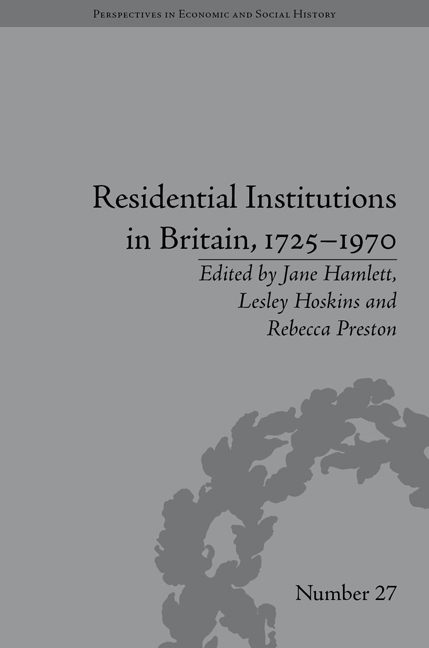Book contents
- Frontmatter
- Contents
- Acknowledgements
- List of Contributors
- List of Figures
- Introduction
- 1 Viewing the Early Twentieth-Century Institutional Interior through the Pages of Living London
- 2 ‘French Beef was Better than Hampstead Beef’: Taste, Treatment and Pauperism in a London Smallpox Hospital, 1871
- 3 From Asylum to Mental Hospital: Gender, Space and the Patient Experience in London County Council Asylums, 1890–1910
- 4 Refuge or Prison? Girls' Experiences of a Home for the ‘Mentally Defective’ in Scotland, 1906–1948
- 5 Paupers and their Experience of a London Workhouse: St Martin-in-the-Fields, 1725–1824
- 6 ‘A Veritable Palace for the Hard-Working Labourer?’ Space, Material Culture and Inmate Experience in London's Rowton Houses, 1892–1918
- 7 ‘The Place was a Home from Home’: Identity and Belonging in the English Cottage Home for Convalescing Psychiatric Patients, 1910–1939
- 8 ‘The Father and Mother of the Place’: Inhabiting London's Public Libraries, 1885–1940
- 9 ‘Discipline with Home-Like Conditions’: The Living Quarters and Daily Life of the Women's Army Auxiliary Corps in First-World-War Britain and France
- 10 Halls of Residence at Britain's Civic Universities, 1870–1970
- Notes
- Index
8 - ‘The Father and Mother of the Place’: Inhabiting London's Public Libraries, 1885–1940
- Frontmatter
- Contents
- Acknowledgements
- List of Contributors
- List of Figures
- Introduction
- 1 Viewing the Early Twentieth-Century Institutional Interior through the Pages of Living London
- 2 ‘French Beef was Better than Hampstead Beef’: Taste, Treatment and Pauperism in a London Smallpox Hospital, 1871
- 3 From Asylum to Mental Hospital: Gender, Space and the Patient Experience in London County Council Asylums, 1890–1910
- 4 Refuge or Prison? Girls' Experiences of a Home for the ‘Mentally Defective’ in Scotland, 1906–1948
- 5 Paupers and their Experience of a London Workhouse: St Martin-in-the-Fields, 1725–1824
- 6 ‘A Veritable Palace for the Hard-Working Labourer?’ Space, Material Culture and Inmate Experience in London's Rowton Houses, 1892–1918
- 7 ‘The Place was a Home from Home’: Identity and Belonging in the English Cottage Home for Convalescing Psychiatric Patients, 1910–1939
- 8 ‘The Father and Mother of the Place’: Inhabiting London's Public Libraries, 1885–1940
- 9 ‘Discipline with Home-Like Conditions’: The Living Quarters and Daily Life of the Women's Army Auxiliary Corps in First-World-War Britain and France
- 10 Halls of Residence at Britain's Civic Universities, 1870–1970
- Notes
- Index
Summary
It was resolved that Mr Henry J. Hewitt be appointed Librarian to the Chiswick Free Public Library at a salary of £90 per annum with rooms, gas and firing, such engagement being determined by a month's Notice [sic] on either side.
‘For the Free Use of the People’: The New Public Libraries in Late-Victorian London
In 1885 there were two public libraries in London supported by rateable income; in 1890 there were twenty-one. By 1906 there were over 100 rate-assisted library buildings, affording ready access to novels, reference books, newspapers and journals for millions of men and women annually. These were cultural institutions that also acted as unofficial information centres, labour exchanges and education hubs, with librarians arranging reading circles, evening classes and lectures for city dwellers wishing to undertake informal learning programmes in their leisure time. The new public libraries had links with the mutual improvement culture but they were aimed at a more numerous and heterogeneous readership. At a time when further education establishments for non-elite students were still not widespread (see William Whyte's chapter on the new civic universities in this volume), the quasi-scholarly ideals and open-doors policy of the so-called ‘free’ libraries meant that these institutions were frequently portrayed as the universities or polytechnics of the people.
- Type
- Chapter
- Information
- Residential Institutions in Britain, 1725–1970Inmates and Environments, pp. 125 - 140Publisher: Pickering & ChattoFirst published in: 2014



